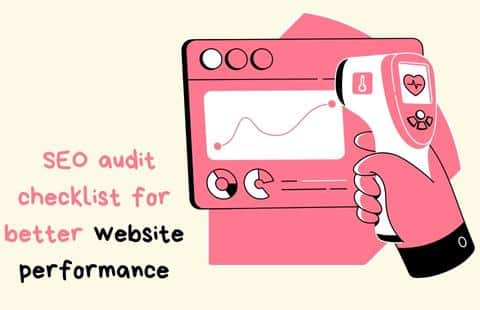- December 30, 2022
- techAdmin
- 0
SEO Audit Checklist- The Ultimate Guide for 2023
There are numerous SEO audit methods available. Whether you’re a small business trying to optimize your website for organic search or an agency doing the same for a client, it can be hard to know where to start, how in-depth your analysis should be, and which SEO audit methods will help you get the most useful information.
To remove a portion of the clamor, we’ve ensured ten center components to a fruitful Website design enhancement review. In addition, we will discuss how to address any issues you discover and the steps required to carry them out.
Whether you are an experienced SEO or a small business owner tinkering with your own Squarespace website, following the ten steps in this guide will get your website on the path to organic search supremacy.
What is an SEO audit?
Reviewing your online assets as part of an SEO audit ensures that your website ranks highly in search results. It includes discovering:
- Strengths and achievements to capitalize on or scale.
- Fixable errors and low-hanging fruit to grab.
- What needs to be fixed and should avoid.
- What needs to be fixed and requires improvement?
The problem is that SEO has so many facets that it can quickly become overwhelming. This post has broken down the SEO audit into ten fundamental steps. However, consider grouping your SEO audits into categories if you have a large website. Several types of SEO audits are discussed further.
Types of SEO audits
If you have a large website, consider the various kinds of SEO audits to divide your SEO audit into different ones.
SEO content audit
It refers to locating opportunities to enhance the quality, accuracy, and regency of the content on the pages you want to rank higher or attract more visitors. Here, use Google E-A-T as your guide.
Later on in this post, we’ll talk more about refreshing and updating content. Opportunities to optimize for the featured snippet, people also ask section, and passage ranking might be part of this audit.
On-page SEO audit
Ensuring a page’s backend elements are optimized for search crawlers is one type of SEO. An on-page SEO audit would check images like alt text and compression, Meta titles, and Meta descriptions.
Off-Page SEO
An off-page SEO audit would look at other pages and domains that link to the pages you want to improve. It could include looking at how many, how well distributed, how often they appear, and how old they are.
Technical SEO audit
On-page efforts like image optimization will be part of this SEO audit. Still, most of it will focus on performance metrics like site speed and security. During a technical SEO audit, there are opportunities to fix, eliminate, or reorganize code, stop spam, switch from HTTP to HTTPS, and more.
Local SEO audit
Local SEO is a set of methods for getting your business to the top of local search results. Although the scope of a local SEO audit will be limited, it will still include components from each of the previous audits.
In terms of off-page listings, on-page content (locally focused pages and posts), keyword insertion and targeting, and technical aspects (site speed and security).
Tools to Audit the SEO Checklists
You will need tools to carry out the SEO audit described in this guide. These are some:
Google Search Console (GSC): For keyword, organic CTR, technical fixes, Core Web Vitals, and submitting any optimized pages for deindexing as a result of your audit, you can use Google Search Console (formerly Webmaster Tools) in a variety of ways.
Google Analytics: Because increasing traffic to your website is the primary objective of an SEO audit, you will need Google Analytics to evaluate the results of your actions. You will also be able to prioritize your efforts based on which pages have experienced significant traffic drops or receive the most traffic.
SEO software: Any SEO software that can compete. A site audit or crawl tool in Ahref, Moz Pro, and SEMrush will enable you to crawl your website and identify general search health and common inefficiencies hindering your site’s organic performance.
They also include tools for keyword research, backlink profiling, and other things. Before undertaking a comprehensive SEO audit of your website, I recommend purchasing at least the free trial version of one of these tools.
The top SEO audit checklist
We have compiled a checklist for a reasonably comprehensive SEO audit that includes technical, off-page, and on-page SEO in light of the preceding section on SEO audit types.
Step 1: Identify link-building opportunities
The building joins a crucial piece of gathering site authority. No Web optimization review is finished without suggestions for building the website’s explicit interior and outside joins.
How to build internal links?
Internal links are essential for creating authoritative hierarchies on your website because they transfer link equity within your pages.
A tried-and-true method for creating internal links: Perform a site search for older, related content that has, ideally, built up some equity before starting a new piece of content; then look for anchor text in the previous content to link to the new content.
How to build external links?
The most crucial aspect of gaining more Domain Authority is acquiring links from a diverse collection of authoritative domains. Searching for resource lists that could realistically feature your content and link to you is a straightforward way to build external links.
Step 2: Find and Fix thin content
Content that doesn’t meet users’ needs is called “thin.” A 300-word blog entry making sense of a perplexing idea is meager. However, putting 1000-2000 words on each page of your website is unrealistic.
Design work—hero images, icons, call-to-action buttons—and a product-centric copy will dominate pages closer to your homepage.
So, which pieces of content should you look at?
Choose pages: You might have found pages with decreased performance or rank. Or, if you provide SEO services, your customer has provided you with a deck containing all the pages they want to be audited.
Top pages: Depending on the size of your website, export your top 25, 50, or 100 pages by traffic and ensure that each is sufficiently enhanced.
All of it: After crawling your site, most site audit tools within the above SEO software will provide a comprehensive report on content length and quality.
Step 3: Identify duplicate content
Google is smart enough to know if you are intentionally and maliciously duplicating content on your website to clog the search engine results page (SERP) with URLs from your website. More than likely, you’re not. If you have duplicate content, it is more likely to be done unintentionally.
Your Content Management System (CMS) may be dynamically creating new pages with similar visuals that have not been manually cannibalized in Search Console. WordPress does this with file pages.
Nonetheless, anything that makes Google’s crawlers think or work harder can hurt your SEO.
Step 4: Make sure Meta tags are optimized.
Meta tags comprise a Meta title and a Meta portrayal. They assist Google in determining the content of the page it is crawling and is two of the more significant aspects it considers when determining the order in which pages should be ranked.
They also serve as advertisements for your content because they assist users in determining the content of your page from search results.
Write or rewrite your Meta tags with your vertical-specific keyword research in mind, optimizing them for the keywords that will help them appear in searches.
Although this is also important for general SEO copywriting, you should avoid keyword stuffing, also known as squeezing keywords in to pack them in, especially in Meta tags.
The wrong title for this article is “10 Great Instagram Captions, Good Instagram Captions, and Funny Instagram Captions That Will Make You ROFL.”
How to improve Meta titles?
Google displays your title’s first 50 to 60 characters. The title is then cut off with an ellipsis after that. Not only could this prevent important keywords from being crawled, but it also looked terrible on the search engine results page.
90% of your titles won’t be cut short if you keep them under 60 characters. Moz offers this valuable and accessible tool for making titles.
Your title should contain your target keyword in its entirety.
To capitalize on its authority, include your brand name in the title.
For instance: Keyword of Interest | Brand Name: i.e., “How to Select the Best Running Shoes | Nike.
How to improve meat descriptions?
The length of an ideal description has fluctuated over time, but it currently ranges between 155 and 160 characters. Here is a rule of thumb regarding content: The winning combination is the target keyword, natural ancillary keywords, descriptors, and call to action.
So: “Website optimization reviews are fundamental for positioning on Google. Get the advice and tools you need to succeed and learn how to conduct an SEO audit in ten easy steps.
Step 5: Run webpage speed analytics
The removal of Google’s Speed Update and Page Experience Update highlights the importance of page speed. It is mainly attributable to the rise in mobile search.
Anyone using a phone to search the internet will not wait for a site that loads slowly. It indicates that Google is more likely to reward you with high organic rankings if your website loads quickly.
Here, Page Speed Insights will be your go-to tool. It offers suggestions for improvement and provides granular insights into page speeds. Page speed can be examined across the entire site:
How to improve site speed?
Compress your images: Assuming you’re searching for fast and compelling page speed improvement, picture pressure is your smartest choice.
Re-upload each image listed in the report to your CMS using a straightforward image compressor like this one. You could see a significant performance boost based on the sizes of your images before and after.
Implement lazy loading: This will ensure your website’s “first paint” occurs as quickly as possible.
Step 6: Scan for the site’s technical errors
A 404 is a “page not found” error commonly happening on your website’s broken links and images. For instance, assuming a page on your site connects linked with a piece of content that has since been erased, any individual who clicks that connection will get a 404 blunder.
Broken links do not lead to site penalties, contrary to popular belief. As happy cycles in and out and your site’s design changes over the long run, 404s usually happen.
However, if you have broken links in the wrong places, it can break your internal linking structure. Users attempting to move from one page to another may also find them a nuisance.
How to find and fix broken links?
All of your website’s 404 errors can be identified with the help of site audit tools. Fixing them starts with figuring out how important each link is to your linking structure and the user experience.
Do you have a page that no longer exists or is now available at a different URL? It’s a good idea to 301 redirect all high-traffic pages that used to link to that page to the new one, or at the very least, they return you to your home page.
Use this SEO audit checklist to get more traffic and rank higher.
There is no one-size-fits-all method for conducting an effective SEO audit. The same factor explains why SEO “best practices” are frequently inconsistent. Google is an enigmatic being.
It rarely explains why or how it changed its algorithm, which changes almost daily. It is impossible to conduct SEO audits in a usual manner. ZabTech IT Solutions is ready to help you to run your SEO Site auditing. To know more details, Contact us!


